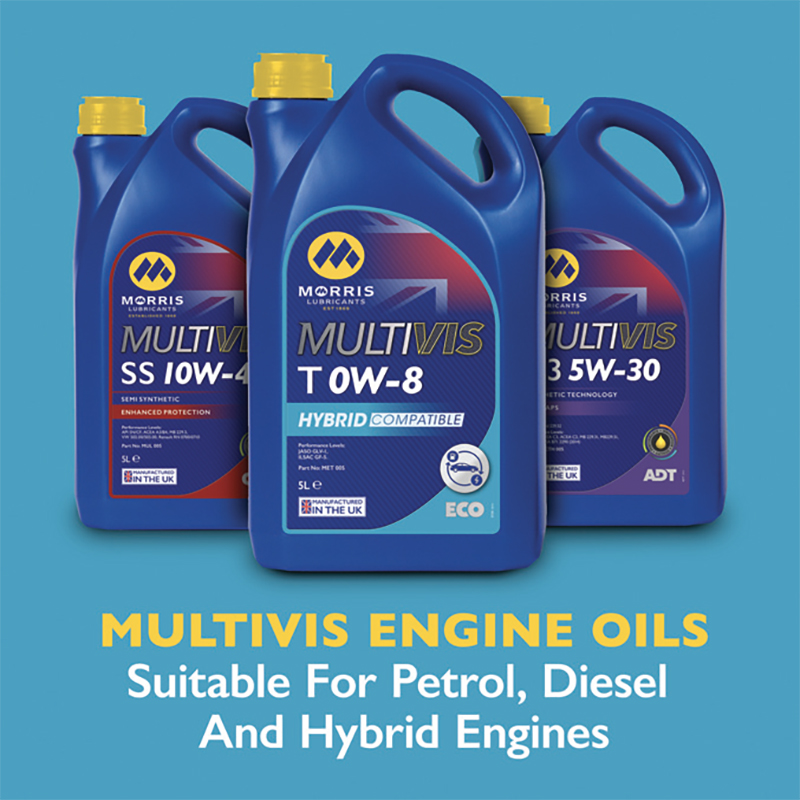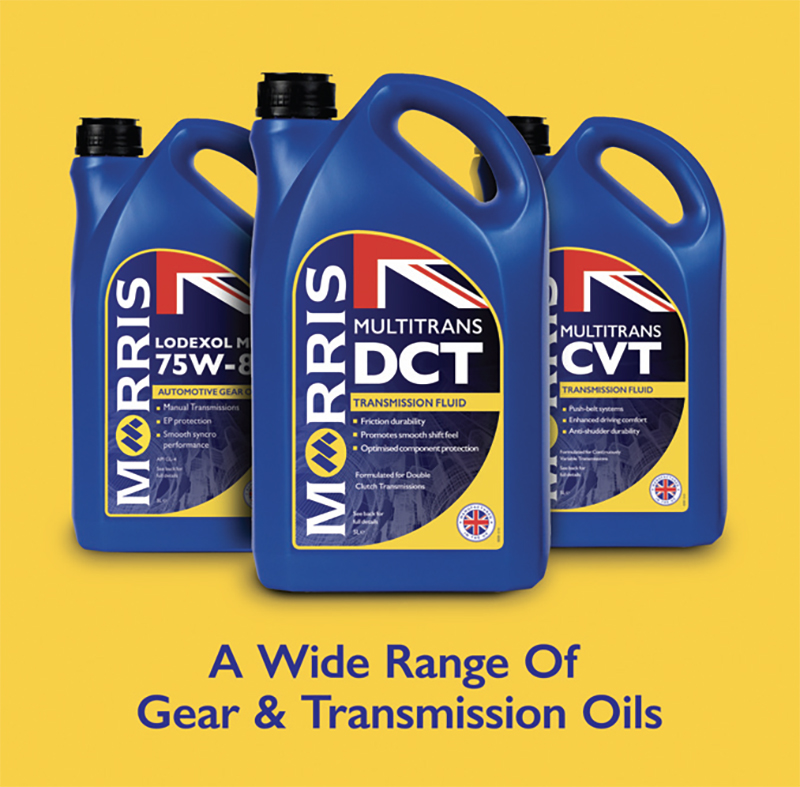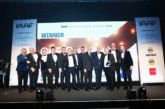How lubricants can help reduce global emissions

With over 40 years of experience in the lubricants industry, Adrian Hill, technology manager at Morris Lubricants, gives his insights on how technology has evolved with car designs and powertrains to help reduce vehicle emissions.
I grew up in the days when diesel cars rattled like a bag of spanners and black smoke billowed out of their exhausts. Petrol cars used carburettors, a choke was needed to start them, and exhaust pipes had a nothing but a silencer. Choice of gearboxes was limited; manual transmissions or automatic transmissions (ATs), with a small number of gear ratios, were the only options.
Today, the only time I see exhaust fumes coming from a car is usually when something bad is happening inside the engine and the end is nigh! Cleaner burning, efficient and quiet internal combustion engines (ICEs) are now part of our everyday lives and, in many ways, are taken for granted. But getting to this position has been a long, tough road, and the role of today’s lubricant manufacturers and the raw materials used has been silent but critical.
The hybrid car solution is still gaining momentum, and they are primarily based on petrol engines. These smaller capacity petrol engines continue to be refined to make them as fuel efficient as possible.
Bigger is no longer seen to be the best, as roaring V8s and V12s are not commonplace on today’s roads. Petrol and diesel engines have reduced in size and, although significantly cleaner burning than their early counterparts, diesels are in decline.
BEVs provide a different solution to help reduce emissions. In the full EV market, we have seen the adaptation of transmission systems from their ICE counterparts, such as dual clutch transmissions (DCTs) and continuously variable transmissions (CVTs). Early models had the transmission as a separate compartment to the electric motor, but, in newer designs, they are now becoming integrated.
All these innovations and step changes to reduce emissions and make the world a cleaner place have relied upon the advancement in oil technology. Lubricant formulations are a balance of raw materials comprising of base oils and additive chemistry. Both have been on their own journeys through the years, and refinement has been key to helping solve the issue of emissions.

Mineral oils were once the mainstay of engine and transmission oil formulations. The build tolerances of engines and transmission were nowhere near as precise as they are now, and the thicker oil films provided by mineral oil helped to seal, cushion and carry the load. But change was on its way, and lubricants had to keep pace.
Modern engines and transmissions are built to a high level of precision, thanks to new methods of manufacturing. Fuel delivery has evolved to high pressure direct fuel injection systems that atomises the fuel more effectively, giving a more efficient burn. Ring packs have moved closer to the piston crown, improving combustion further. Power output has been improved with supercharging and turbocharging. Newer lighter build materials have been adopted to reduce weight. Engine capacities have trended to smaller displacement. Tailpipe emissions are controlled with after-treatment devices, such as DPFs, GPFs, SCR – AdBlue, NOx reduction systems, three-way catalysts, EGR and DOCs.
Transmissions have also evolved to a high state of complexity and choice. Putting manual gearboxes to one side, as they require the driver’s judgement when it comes to gear changes, we have seen advanced designs that use computer control to maximise efficiency. Automatics can now have up to 10 ratios, a strategy that reduces the amount engine revs drop between gears, resulting in better fuel efficiency. DCTs moved the lowly manual transmission into a whole new world, providing rapid gear changes and improvements in fuel efficiency. We have also seen CVTs join the lineup, using belts and cones to provide seamless, infinite gear ratios.
Importance of efficient and effective lubrication
These new highly efficient ICEs and transmissions need highly efficient and effective lubricants for them to work correctly. Base oil technology, the foundation for any lubricant, used to be a simple affair, but is now divided into five family groups (Group I, II, III, IV, V) as categorised by the American Petroleum Institute (API), each providing an increased level of performance.
As demands on the lubricants have increased, more robust and tailored base oil technology has had to be developed to underpin these critical formulations. As we progress from Group I through to Group V, increased levels of molecular processing are introduced to refine their physical and chemical characteristics, resulting in highly sophisticated fluids. Oil formulations have moved to become a more complicated chemical and manufacturing process.
To make an engine more fuel efficient, lubricants that produce an ultra-low oil film now form part of the solution. Energy is expended whilst trying to move the lubricant around the engine, so if we can reduce ‘viscous drag’ we improve fuel efficiency.

Improved fuel efficiency translates into lower emissions, the desired end goal for these newer designs. The targeted areas are between the journal and bearings and piston and liner. But this requires advanced base oils that can cope with higher temperatures due to the ring packs being higher, without severe decomposition and evaporation loss. The same base oils have got to circulate at very low temperatures, down at -35oC, in the new raft of 0W grades.
This is because fuel economy benefits need to start straightaway on start-up. The oil film generated between journal and bearing is strong, but under high load may need reinforcing. This is achieved using polymers that are present in the oil formulation.
Rapid start circulation is another required feature of stop/start operation to reduce fuel usage. This is also highly critical in the world of hybrids. Depending on the type of hybrid configuration, the ICE may have to start from cold and immediately find itself doing 70mph. The lubricant must be capable of being pumped from the sump to the critical valve gear and bearings in a blink; otherwise, catastrophic wear will take place! Only the latest base oil technology and chemical additives make this possible.
While all of these refinements in base oil technology have been taking place, the active additive chemistry has also been subjected to innovation. As highlighted, the incorporation of after-treatment devices has helped control emissions, but they are sensitive to lubricant chemistry. The ‘wrong’ chemistry will block the likes of the DPF and GPF, as well as poisoning catalysts, like the SCR – AdBlue. Here we have a difficult balancing act: the active chemistry must protect the engine components. It must control wear, corrosion, disperse soot, neutralise harmful acids, but, simultaneously, ensure after-treatment devices enjoy maximum service life – not easy!
OEMs design engines and transmissions while setting oil specifications tailored to maximise component longevity and service life. As they continue refining these systems to achieve optimal emissions reduction, meeting these evolving standards becomes increasingly challenging.
The hardware will only achieve this if the correct advanced lubricant is used. Without the lubricant formulators playing their part, we would not be heading in the right direction in terms of reducing atmospheric pollution. Advanced lubricants are part of this solution.
EVs and the role lubricants play
E-transmissions, whether DCT, CVT or AT, require lubrication. In early versions, these systems operated as per their ICE counterparts – driven by a motor or battery in their own separate compartment. This made lubrication very straightforward.
However, newer generation e-transmissions have a requirement for the electric motor to be cooled. This is done by combining the e-transmission and the motor in one compartment, filled with the same fluid.
This has required a step change in lubrication, and industry tests have had to be developed to ensure any lubricant technology used is fully compatible with the electric motor components, particularly the copper windings. Only advanced lubrication chemistry and precise oil formulations can make this happen and keep the EV on the road.
Final word
Modern lubricants have evolved; sophisticated refining practices, chemical processing and tailored additive chemistry have given rise to a whole new generation of lubricants. This new generation of critical components plays a vital role in the latest engine and transmission designs, ensuring that modern vehicles meet their promised clean performance standards.








